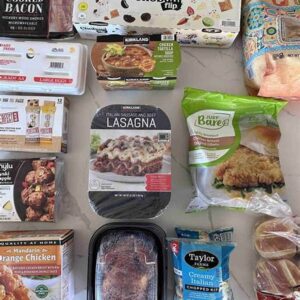- The Game-Changer Effect
- Effective Utilization of Cold Storage: Real Stories
- From Tech Novices to Cold Seasoned Experts
- Unveiling Colder Horizons
- The Impact of Cold Storage Technology
- Related Topics on Cold Storage Technology
- Introduction to Cold Storage in Rural Meal Prep
- Real-World Impact of Cold Storage
- Illustrations of Cold Storage Tech Benefits
Sure! Let’s start by creating a detailed article discussing how cold storage technology is revolutionizing meal prep in rural areas.
Read More : Why Batch Cooking Saves Time And Money
—
Imagine living in a rural area where getting fresh groceries is not a quick run to the store but a journey bound by time and distance. In places far removed from bustling urban centers, the challenge of keeping food fresh and reducing spoilage is daunting. This is where cold storage technology becomes a game-changer. But how exactly does it transform meal prep in these isolated locales? Let’s unravel this chill revolution.
First, imagine the simple task of weekly meal prep—this can turn into an ordeal when fresh ingredients aren’t available. Cold storage technology, including refrigerated units and innovative cool storage techniques, provides an essential buffer between farm and table. According to recent data from a study by the Agricultural Research Department, food spoilage accounts for up to 25% of waste in rural households. Here’s where technology steps in; powerful, energy-efficient, and sustainable solutions ensure that perishable items stay fresh longer. Suddenly, meal preparation shifts from a frantic rush to a leisurely task, allowing residents to plan meals days in advance without fear of spoilage.
The Game-Changer Effect
What’s more compelling than the cool tech itself is the empowerment it delivers. Cold storage tech helps meal prep in rural areas by stabilizing food supply chains and reducing dependency on frequently unreliable grocery store trips. A local farmer, Tom, shared how his community’s cooperative invested in a solar-powered cold storage facility. Now, produce from his fields feeds neighborhood families far beyond the harvest season. “I never thought keeping carrots fresh was rocket science until I saw our produce last weeks more,” Tom chuckles with pride.
Effective Utilization of Cold Storage: Real Stories
Innovative applications are cropping up everywhere, making a genuine impact. In small towns, non-profits set up shared storage units to hold communal goods accessible to all, reducing individual costs while maximizing utility. It’s a collective operation, but with everyone driving their meals to delicious completion, there’s a tangible excitement in the air. One community leader mentioned, “It’s as if we lit up a beacon of freshness in a food desert.”
From Tech Novices to Cold Seasoned Experts
But let’s not overlook the human element. Embracing tech can feel daunting, especially where there’s skepticism or technology is often too complex. However, through workshops and practical demonstrations, residents have learned to wield this tech as a tool of empowerment. “There was hesitation at first, but seeing how cold storage tech helps meal prep in rural areas has brought new life to our kitchens,” says Linda, an enthusiastic rural meal planner.
Unveiling Colder Horizons
Cold storage technology transforms how rural areas perform meal preparation. From extending the shelf life of perishables to empowering local economies, these cool innovations turn daily meals from a chore to a choice. Can you imagine the possibilities that lie ahead as this technology becomes more accessible and sophisticated?
—
The Impact of Cold Storage Technology
Let’s explore in depth the impact made by cold storage technology in rural meal prep environments and how it enriches lives in multifaceted ways.
The Economic Ripple: Financial Gains in Freshness
Costs are a massive factor in rural food prep. Cold storage significantly cuts down costs related to food spoilage. By preserving perishable food longer, families don’t need to purchase groceries as often or in large quantities. It’s an economic ripple effect—cost savings for families can be redirected towards other needs like education and health.
Cold storage isn’t just about keeping food; it’s about keeping options open. The same study by the Agricultural Research Department noted that families using this tech see a 30% reduction in grocery bills. Local economies are thriving not just because of fewer trips to distant stores, but due to the shared cost-efficiency stemming from localized cold storage solutions.
Harmonizing Tech and Tradition
Invention doesn’t replace tradition; it collaborates. Grandmothers are notorious for keeping tricks to make food last. Cold storage innovates on what these wise heads have always known—small, consistent temperature adjustments can work wonders. By marrying tech with traditional methods, we’re seeing a culinary renaissance in rural areas.
Cold Storage Success Stories
Incorporating cold storage technology leads to success stories filled with warmth. Mrs. Jenkins, from Coldville, smiles while she speaks, “We used our savings from fewer grocery runs to renovate our community hall. It’s amazing how cold storage tech helps meal prep in rural areas.”
Exploring Alternatives and Sustainability
While electricity in rural zones may be unreliable, innovations like solar-powered refrigeration and thermally insulated storage boxes offer sustainable options. The intersection of sustainability with fresh meal options embodies progress that is heartwarming to witness.
Vision for the Future: Expanding Cold Horizons
What lies ahead? Beyond enhancing meal prep, cold storage tech holds promise for larger agricultural scopes. Imagine entire communities adopting sustainable practices, reducing waste while ensuring food security—this vision drives many to invest and dream bigger.
—
Related Topics on Cold Storage Technology
Here are six topics to further explore:
—
Introduction to Cold Storage in Rural Meal Prep
In rural settings where community is everything, finding practical solutions to everyday problems becomes a collective effort. Cold storage technology isn’t just a luxury but a fundamental shift in how residents manage their resources. From enhancing the life of perishable goods to stimulating local economies and reducing waste, the insights shared about how cold storage tech helps meal prep in rural areas introduce a fresh perspective to rural life.
Providing an accessible way to bridge the gap between modern conveniences and remote living, cold storage solutions promise not only superior meal prep but also an opportunity for communities to thrive in novel ways. Families can now consider luxury recipes as options, all the while knowing there’s ample time to plan, purchase, and prepare without the risk of spoilage. Rural life, thus, takes on a new dynamism with the support of cold storage solutions.
With stories of success and a future brimming with possibilities, the integration of cold technology might just be the catalyst for substantial growth and development in rural communities. Not only are they preserving the past; they’re very much preparing for a delicious future.
—
Real-World Impact of Cold Storage
Delving deeper, let’s examine how cold storage tech can bring about significant community changes—social, economic, and environmental benefits unfold as we explore these innovations more closely.
Economic Benefits on Meal Prep
One of the top advantages centers on economic savings. Food spoilage often leads to unnecessary household costs that could go toward more vital expenses. With the integration of cold storage technology, there’s a notable decrease in food-related waste.
Enhancing Community Health and Nutrition
Moreover, in rural areas, where access to health services is limited, nutrition becomes paramount. Cold storage encourages consumption of fresher ingredients, leading to healthier lifestyles and reducing health risks associated with suboptimal diets.
Environmental Considerations
Environmentally, rural areas see decreased waste and there’s an uptick in utilizing renewable energy forms to power these cold storage facilities. The sustainability factor is not just trendy. It’s a conscious choice that represents progress and a suitable model for other areas.
The Social Fabric of Rural Communities
The ripple effects extend socially. As people gather around shared resources, solidarity within communities strengthens. Meal prep turns into an act of communal goodwill—a place and time where ideas and meals are shared alike.
Looking to the Future
Rural cold storage adoption remains a beacon of hope and a model of ingenuity. As awareness and technology rise, it’s not just how cold storage tech helps meal prep in rural areas, but how it exemplifies progress and pride for entire communities.
—
Illustrations of Cold Storage Tech Benefits
Below are six illustrations regarding how cold storage tech assists rural meal prep:
Description
Each of these illustrations offers a tangible visualization of the profound effects cold storage technology has in transforming rural meal prep. By distilling complex changes into digestible visuals, these aids make it easier for those unfamiliar with the technology to grasp its benefits and long-term impacts.
These illustrations serve not only as educational tools but as aspirational imagery for communities that envision embracing such innovation. They can inspire further adoption, foster discussions around sustainable progression, and ultimately transform the lives of those residing in rural areas, who, for so long, managed largely without such vital advancements.




